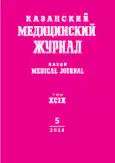Estimation of the risk factors in pregnant women and prediction of congenital fetal anomalies
- Authors: Dzhamankulova FS1, Musuraliev MS2, Sorokin AA3
-
Affiliations:
- National Centre for the Protection of Motherhood and Childhood
- Kyrgyz State Medical Academy
- Kyrgyz-Russian Slavic University, the Institute of Mountain Physiology NAS KR
- Issue: Vol 99, No 5 (2018)
- Pages: 748-753
- Section: Theoretical and clinical medicine
- URL: https://bakhtiniada.ru/kazanmedj/article/view/10296
- DOI: https://doi.org/10.17816/KMJ2018-748
- ID: 10296
Cite item
Full Text
Abstract
Aim. To estimate the value of different maternal risk factors to develop a prognostic model for prevention of fetal congenital anomalies.
Methods. A prospective complex clinical and laboratory and functional examination of 629 pregnant women with fetal congenital anomalies and 206 pregnant women without fetal pathology was conducted with a comparative assessment of the medical and social risk factors for congenital defects. To build a predictive model for prevention of congenital anomalies, the logistic regression method was used.
Results. According to static analysis, significant medical and social risk factors for congenital anomalies are acute respiratory viral infection with fever in early gestational age (OR=20.0, 95 % CI: 2.756-145.7), the absence of prophylactic folic acid (OR=15.16, 95 % CI: 7.35-31.31), polyhydramnion (OR=14.2, 95 % CI: 4.453-45.18), oligohydramnion (OR=3.258, 95 % CI: 1.382-7.679), preeclampsia (OR=3.51, 95 % CI: 1.11-8.96) and maternal anemia (OR=4.75, 95 % CI: 2.51-8.99). As a result, we received the predictive model with high sensitivity equal to 0.924, specificity 0.655 and Sommers’ D 0.629. Nagelkerke’s R square of the model was 0.552 (moderate). This means that the model explains 55.2 % variation of the dependent variable.
Conclusion. The conducted study allowed identifying the predictors affecting the development of congenital fetal anomalies, and the developed predictive model for determining the probability of congenital fetal anomalies in the early antenatal period is characterized by high sensitivity and can be suggested for the use during the monitoring phase of the pregnant woman in the outpatient setting.
Full Text
##article.viewOnOriginalSite##About the authors
F S Dzhamankulova
National Centre for the Protection of Motherhood and Childhood
Author for correspondence.
Email: fatima.djamankulova@mail.ru
Bishkek, Kyrgyz Republic
M S Musuraliev
Kyrgyz State Medical Academy
Email: fatima.djamankulova@mail.ru
Bishkek, Kyrgyz Republic
A A Sorokin
Kyrgyz-Russian Slavic University, the Institute of Mountain Physiology NAS KR
Email: fatima.djamankulova@mail.ru
Bishkek, Kyrgyz Republic
References
- Bokonbaeva S.Dzh., Aldasheva N.M., Lobzova A.V. Congenital malformations as an indicator of environmental quality. Vestnik Kyrgyzsko-Rossiyskogo Slavyanskogo Universiteta. 2008; 8 (4): 165–70. (In Russ.)
- Sbitneva V.N., Glebova L.A., Shabaldina A.V., Brailovskiy V.V. Regional monitoring of congenital malformations in the Orenburg region. Prakticheskaya meditsina. 2010; 5: 161. (In Russ.)
- Statistical Report of the Republican Medical Information Center of the Kyrgyz Republic for 2007–2016. (In Russ.)
- Kokushin D.N., Murashko V.V, Khusainov N.O, Bogatyrev T.B. Surgical treatment of children with congenital anomaly of the spine and cord. Mezhdunarodnyy zhurnal prikladnykh i fundamental’nykh issledovaniy. 2017; 7 (2): 195–197. (In Russ.)
- Korsak A.K, Terekhova T.N, Kuznetsova S.V, Kushner A.N. Congenital malformations of the maxillofacial region in children. MGMI. 2000. (In Russ.)
- Congenital anomalies. World Health Organization. 2016. http://www.who.int/ru/news-room/fact-sheets/detail/congenital-anomalies. (In Russ.)
- Czeizel A.E. Experience of the Hungarian Preconception Service between 1984 and 2010. Eur. J. Obstet. Gynecol. Reprod. Biol. 2010; 161 (1): 18–25. DOI: 10.1016/ j.ejogrb.2011.12.019.
- Antonova V.I., Bogacheva E.V., Kitaeva Yu.Yu. The role of exogenous factors in the formation of congenital malformations. Ekologiya cheloveka. 2010; 6: 30–36. (In Russ.)
- Bashmakova M.A., Savicheva A.M. Congenital and perinatal infections: problems and solutions. Zhurnal akusherstva i zhenskikh bolezney. 2010; 59 (5): 17–22. (In Russ.)
- Kuznetsov M.I. Rubella during pregnancy: the first experience of prenatal diagnosis and maintenance of pregnancy. Prenatal’naya diagnostika. 2002; 1 (4): 291–293. (In Russ.)
- Selyutina M.Yu., Evdokimov V.I., Sidorov G.A. Congenital malformations as an indicator of the ecological state of environment. Nauchnye vedomosti Belgorodskogo gosudarstvennogo universiteta. Series: Medicine. Pharmacy. 2014; 26 (11): 173–77. (In Russ.)
- Lazzarotto T., Gabrielli L., Guerra B. et al. Diagnosis and prognosis of congenital CMV infection: a case report and review of the literature. Scand. J. Clin. Lab. Invest. Suppl. 2014; 244: 34–40.
- Ustinova O.Yu., Permyakov I.A. Influence of environmental factors on the formation of congenital anomalies in children living in the area affected by the enterprises of the oil processing complex. Vestnik Permskogo universiteta. 2012; 1: 64–67. (In Russ.)
- Mazur L.I., Abramova O.A. Medico-social aspects of formation of congenital malformations in the fetus. Izvestiya Samarskogo nauchnogo tsentra Rossiyskoy akademii nauk. 2009; 11 (1): 891–894. (In Russ.)
- Soloveva G.V., Serebrennikova T.E. Genetic burden in the structure of infant mortality: assessement, dynamics, and prospects. Prakticheskaya meditsina. 2013; (6): 100–102. (In Russ.)
- Falyush L.N., Florentsev V.V. Risk factors of congenital heart defects. Byulleten’ Vostochno-Sibirskogo nauchnogo tsentra SO RAMN. 2010; 6 (2): 67–69. (In Russ.)
- Bochkov N.P., Puzyrev B.P., Smirnokhina S.A. Klinicheskaya genetika. (Clinical Genetics.) 4th Ed. GEOTAR-Media. 2010; 554 p. (In Russ.)
- Lazyuk G., Kirillova I.A., Kravtsova G.I. Teratologiya cheloveka. (Human Teratology.) 1991. (In Russ.)
- Tsurkan S.V. Strategy of population prevention of congenital pathology. Kazan medical journal. 2011; 92 (3): 449–452. (In Russ.)
Supplementary files






